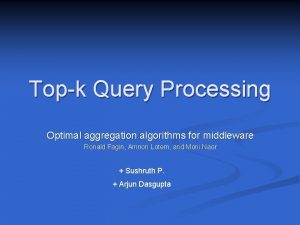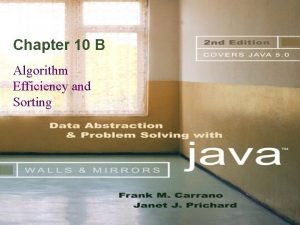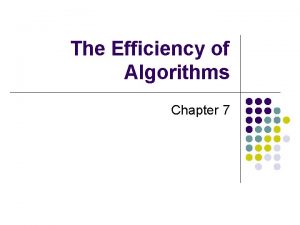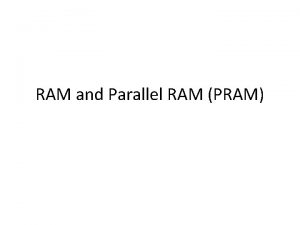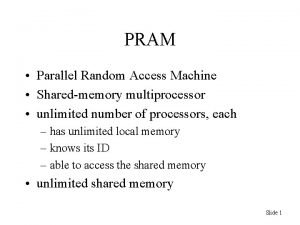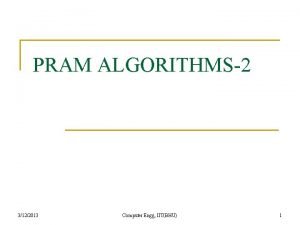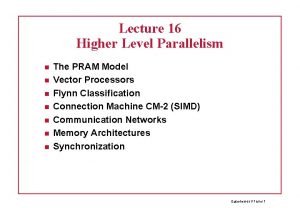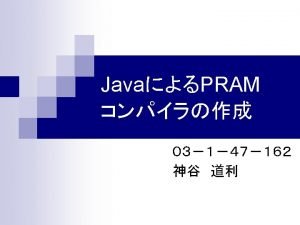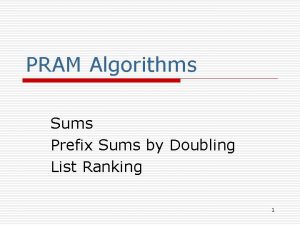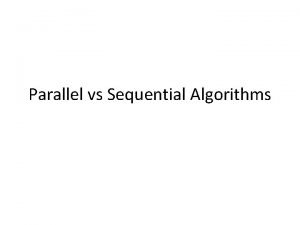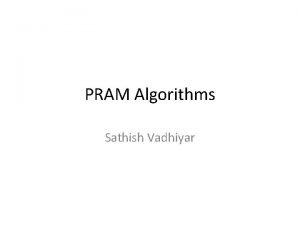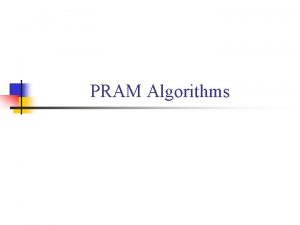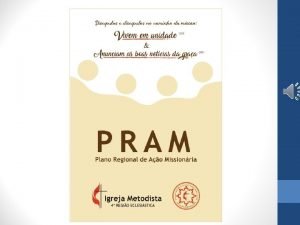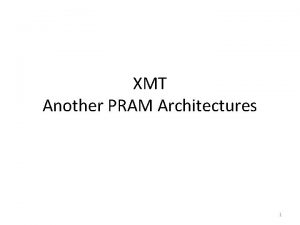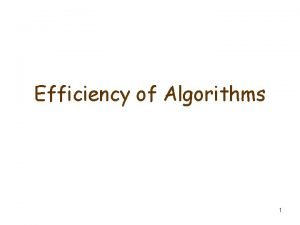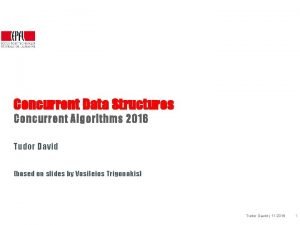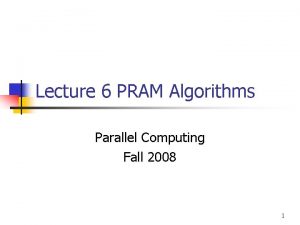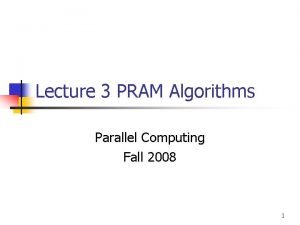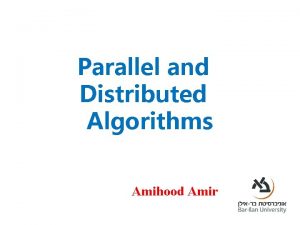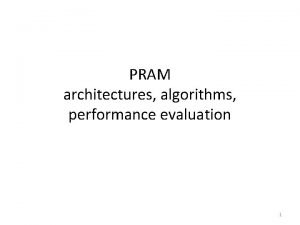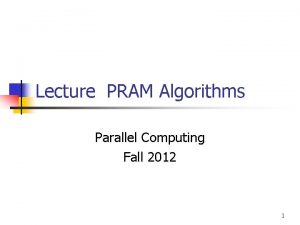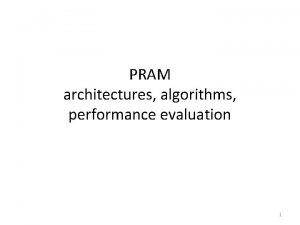Optimal PRAM algorithms Efficiency of concurrent writing Computer


















- Slides: 18

Optimal PRAM algorithms: Efficiency of concurrent writing “Computer science is no more about computers than astronomy is about telescopes. ” Edsger Dijkstra (11/05/1930 -6/9/2002)

One more time about PRAM model w N synchronized processors w Shared memory n EREW, ERCW, n CREW, CRCW w Constant time n access to the memory n standard multiplication/addition n Communication (implemented via access to shared memory)

Covered so far… in COMP 308 w Metrics … efficiency, cost, limits, speed-up w PRAM models and basic algorithms w Simulation of Concurrent Write (CW) with EW w Parallel sorting in logarithmic time TODAY’s topic: how fast we can compute with many processor and how to reduce the number of processors?

Two problems for PRAM Problem 1. Min of n numbers Problem 2. Computing a position of the first one in the sequence of 0’s and 1’s.

Min of n numbers w Input: Given an array A with n numbers w Output: the minimal number in an array A Sequential algorithm ? Cost = 1 n … Sequential Optimal Par. Cost = O(n) vs. Parallel At least n comparisons should be performed!!! COST = (num. of processors) (time)

Mission: Impossible … computing in a constant time w Archimedes: Give me a lever long enough and a place to stand I will move the earth w NOWDAYS…. Give me a parallel machine with enough processors and I will find the smallest number in any giant set in a constant time!

Parallel solution 1 Min of n numbers w Comparisons between numbers can be done independently w The second part is to find the result using concurrent write mode w For n numbers ----> we have ~ n 2 pairs [a 1, a 2, a 3, a 4] (ai , aj) 1 (a 3, a 4) (a 1, a 3) (a 1, a 2) (a 2, a 4) (a 1, a 4) (a 2, a 3) i j n 1 0 M[1. . n] 000000000000000000000000 If ai > aj then ai cannot be the minimal number

The following program computes MIN of n numbers stored in the array C[1. . n] in O(1) time with n 2 processors. Algorithm A 1 for each 1 i n do in parallel M[i]: =0 for each 1 i, j n do in parallel if i j C[i] C[j] then M[j]: =1 for each 1 i n do in parallel if M[i]=0 then output: =i

From n 2 processors to n 1+1/2 A 1 A 1 A 1 Step 1: Partition into disjoint blocks of size Step 2: Apply A 1 to each block Step 3: Apply A 1 to the results from the step 2 A 1

From n 1+1/2 processors to n 1+1/4 A 2 A 2 A 2 Step 1: Partition into disjoint blocks of size Step 2: Apply A 2 to each block Step 3: Apply A 2 to the results from the step 2 A 2

n 2 -> n 1+1/4 -> n 1+1/8 -> n 1+1/16 ->… -> n 1+1/k ~ n 1 w Assume that we have an algorithm Ak working in O(1) time with processors Algorithm Ak+1 1. Let =1/2 2. Partition the input array C of size n into disjoint blocks of size n each 3. Apply in parallel algorithm Ak to each of these blocks 4. Apply algorithm Ak to the array C’ consisting of n/ n minima in the blocks.

Complexity w We can compute minimum of n numbers using CRCW PRAM model in O(log n) with n processors by applying a strategy of partitioning the input Par. Cost = n log n

Mission: Impossible (Part 2) Computing a position of the first one in the sequence of 0’s and 1’s in a constant time. 00000000000000000000000000000000000000000000000000000000 0000000000000000000000000000001000 00101000 000000000000000100000000000001 00000000000000010000000000000 01101000 00000000000000010000001111110000000000000000000000000000 00010100 00000000000000000000000000001000000000000000000000000000011111111111111100000000000000000000000000000000000000000000000000000000000000000000000000000000000000000000000000000000000000000000000000000000000000000000000000000000000000000000000000000000000000000000000000000000000000000000000000000000000000000000000000000000000000000000000000000000000000000000000000000000000000000000000000000000000000000000000000100000000000000000000000000000000000000000000000000000000010000000000000000000000000000000010000000000000000000000000000000000000000000000000000000000000000000000000000000000000000000000000000000000000000000000000000000000000000000000000000000000000000000000000000000000000000000000000000000000000000000000 0000000000000001000000111111110000000000001000000000000000000000000000000000000000000000000000000000100000000000000000000100000000000000000000000000000000000000000000001000000111111110000000000001000000000000000000000000000000000000000000001111111111100000

Problem 2. Computing a position of the first one in the sequence of 0’s and 1’s. Algorithm A (2 parallel steps and n 2 processors) for each 1 i<j n do in parallel if C[i] =1 and C[j]=1 then C[j]: =0 for each 1 i n do in parallel if C[i] =1 then FIRST-ONE-POSITION: =i FIRST-ONE-POSITION(C)=4 for the input array C=[0, 0, 0, 1, 1, 1, 0, 0, 0, 1] 1 1 1 0 After the first parallel step C will contain a single element 1

Reducing number of processors Algorithm B – it reports if there is any one in the table. There-is-one: =0 for each 1 i n do in parallel if C[i] =1 then There-is-one: =1 1 1 000000000 1

Now we can merge two algorithms A and B 1. 2. 3. 4. Partition table C into segments of size In each segment apply the algorithm B Find position of the first one in these sequence by applying algorithm A Apply algorithm A to this single segment and compute the final value B B B A A B B B

Complexity w We apply an algorithm A twice and each time to the array of length which need only ( )2 = n processors w The time is O(1) and number of processors is n.

Homework: w Construct several algorithms A 1, A 2, A 3, A 4. . . for MIN problem reducing number of processors w Define the algorithm Ak for MIN problem in terms of A 1 only [not in terms of A(k-1) ] w How to formulate the algorithm Ak in a direct way?
 Synchronization algorithms and concurrent programming
Synchronization algorithms and concurrent programming Optimal aggregation algorithms for middleware
Optimal aggregation algorithms for middleware Efficiency of sorting algorithms
Efficiency of sorting algorithms Complexity of algorithm
Complexity of algorithm Algorithm efficiency
Algorithm efficiency Allocative efficiency vs productive efficiency
Allocative efficiency vs productive efficiency Allocative efficiency vs productive efficiency
Allocative efficiency vs productive efficiency Productive inefficiency and allocative inefficiency
Productive inefficiency and allocative inefficiency Parallel random access memory
Parallel random access memory Multiprocessor
Multiprocessor Pram
Pram Pipelineing
Pipelineing Elements of modern computer system
Elements of modern computer system Nistir 8062
Nistir 8062 Pram model of negotiation
Pram model of negotiation Score pram asthme
Score pram asthme Pram
Pram Packed prefix
Packed prefix Parallel vs sequential algorithms
Parallel vs sequential algorithms

